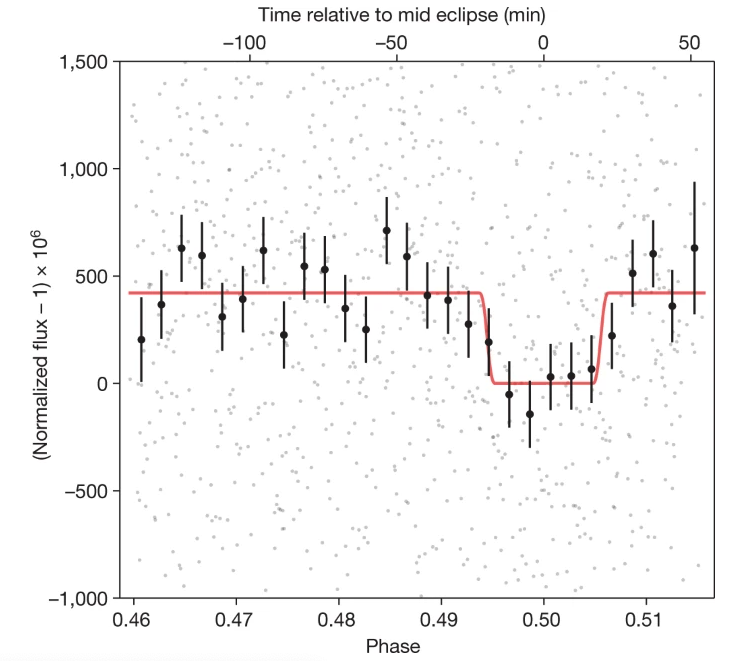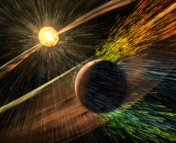Title: No thick carbon dioxide atmosphere on the rocky exoplanet TRAPPIST-1 c
Authors: Sebastian Zieba, Laura Kreidberg, Elsa Ducrot, Michaël Gillon, Caroline Morley, Laura Schaefer, Patrick Tamburo, Daniel D. B. Koll, Xintong Lyu, Lorena Acuña, Eric Agol, Aishwarya R. Iyer, Renyu Hu, Andrew P. Lincowski, Victoria S. Meadows, Franck Selsis, Emeline Bolmont, Avi M. Mandell and Gabrielle Suissa
First Author’s Institution: Max-Planck-Institut für Astronomie, Heidelberg, Germany; Leiden Observatory, Leiden University, Leiden, The Netherlands
Status: Published in Nature [open access]
Since JWST launched, astronomers have been on the hunt to detect molecules in the atmospheres of exoplanets, specifically those of small and rocky planets like our planet Earth. Through JWST, they hope to start the quest of answering whether terrestrial exoplanets have atmospheres and what their composition could be. If astronomers are able to detect and determine what their atmospheres are made of or find that an exoplanet has no atmosphere, then we can learn more about how the planet evolved over time and start studying whether life could have potentially taken place or is currently occurring on the planet.
The TRAPPIST-1 system offers an unique opportunity to study terrestrial planets around smaller and cooler stars called M-dwarfs. This system has seven terrestrial planets and some are in the habitable zone of its star, offering us the opportunity to study planets at a variety of distances from their star in the same system. Today’s authors seeked to answer whether the second innermost planet, TRAPPIST-1c, had an atmosphere and if so, what molecules made up their atmosphere. While this planet is not in the habitable zone, it provides insight into planets closer in to their star. What can these results tell us about the planet and about the planetary system as a whole?
How to Vibe Check an Exoplanet
There are direct ways to detect and characterize the atmosphere of an exoplanet, but today’s technique consists of looking at the thermal emission coming from a planet as the planet passes behind the star during its orbit, also known as a secondary eclipse. By looking at the side of the planet that is being irradiated by the star, also known as the dayside, astronomers can measure the dayside temperature. This can tell us a lot about whether the planet has an atmosphere. If such a planet had an atmosphere, we would expect temperatures that would show that heat is being distributed from the dayside (side receiving light from the star) to the nightside (side not receiving light from the star). If a planet did not have an atmosphere, then we would expect higher temperatures representative of no heat distribution between planet sides.
The authors for today’s paper used the Mid-Infrared Instrument (MIRI) on JWST to observe the thermal emission of TRAPPIST-1c four times as it went behind the star. Within the Mid-Infrared Instrument (MIRI), they used a filter that covered a wide range in wavelength space. Specifically where carbon dioxide (CO2) would show a strong absorption feature in the data if present in the atmosphere of the planet. In Figure 1, we can see the eclipse light curve of TRAPPIST-1c from this paper.

After they measured the eclipse depth, they derived a brightness temperature for the dayside of TRAPPIST-1c of around ~380 Kelvin. For comparison, the brightness temperature for the innermost planet in the system, TRAPPIST-1b, was around 503 Kelvin. With this new temperature measurement for TRAPPIST-1c, we finally have a comparable temperature to the planets in our Solar System. For example, Mercury and Venus have equilibrium temperatures of 440 Kelvin and 227 Kelvin respectively, so observing an exoplanet with a similar temperature gives us an insight on the planet’s properties.
TRAPPIST-1c – No Chill
From the temperature measurements, the authors started to model what physical scenarios could explain the observations. Based on the derived temperature, they looked at two limiting cases for how well the atmosphere circulates: one case with no heat distribution between dayside and nightside and another with global heat distribution expected from a thick atmosphere. They also explored which atmospheres for different surface pressures and different amounts of carbon dioxide and oxygen were consistent with the data, as seen in Figure 2.

The results show that these observations both agree with either a thin CO2 atmosphere or a bare rock, which refers to a planet with no atmosphere. This matches the previous same result for TRAPPIST-1b, which is also indicative of a bare rock. The authors highlight that while more observations are needed to understand these planets and other M-dwarf planets in detail, JWST has already shown the potential it has for studying rocky planets. TRAPPIST-1c is the smallest exoplanet with a measured flux and the planet with the lowest temperature for a transiting exoplanet. With JWST, astronomers hope to uncover the mystery of terrestrial exoplanets and their atmospheres, especially around the TRAPPIST-1 system.
Astrobite edited by Mark Popinchalk
Featured image credit: NASA, ESA, CSA, Joseph Olmsted (STScI)




